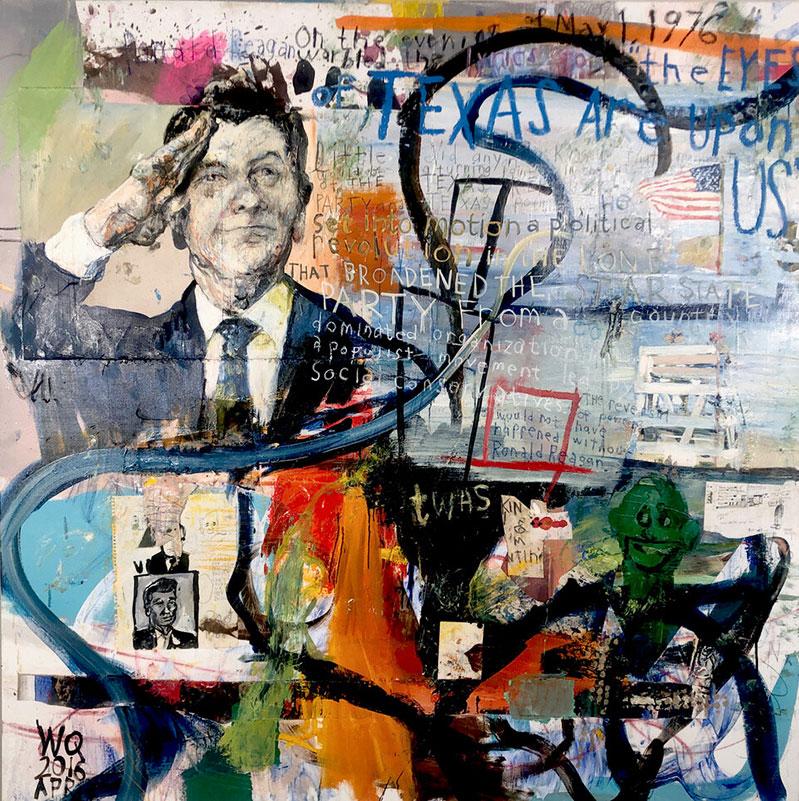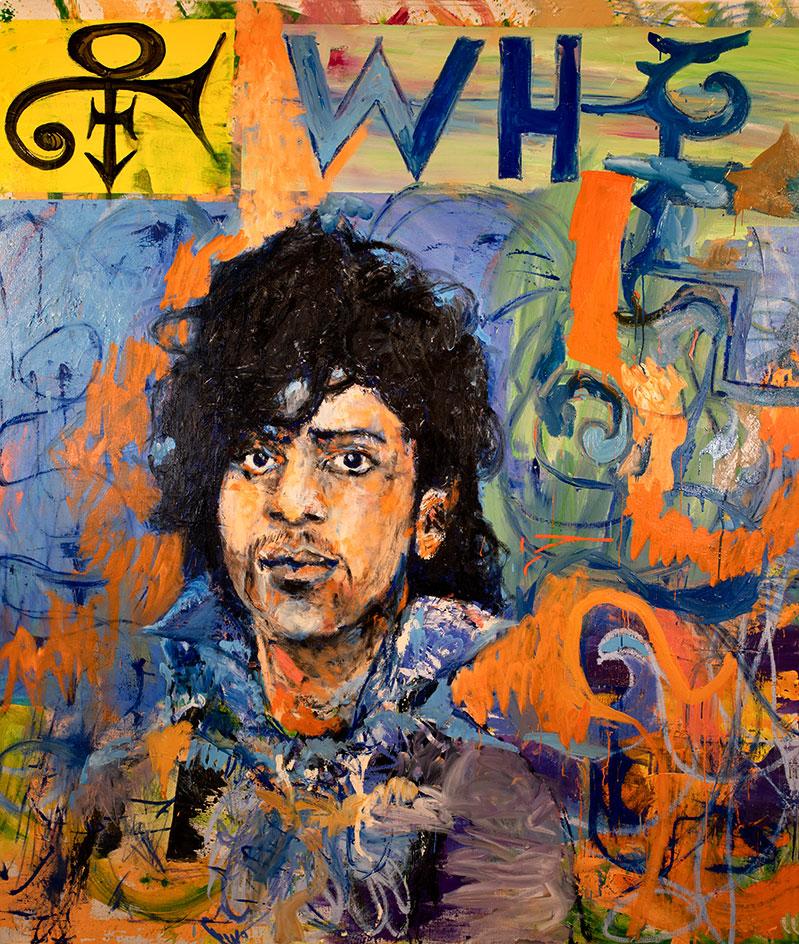Trying to capture the essence of William Quigley is like chasing after a drop of water in a pond. The words come fast and his stories spread out so quickly, it's near impossible to grasp their entirety.
In a conversation last week, he spoke about his success even with continuous struggles to be seen and represented. This is despite early gallery attention in Philadelphia, where he is from; New York, where he attended graduate school at Columbia University, and Los Angeles, where he lived for 10 years, including during the riots of 1992, which happened not far from his studio there.
When he is written about, it is often for things easier to define, such as the purchase of his portrait of Donald Trump through a straw bidder, allegedly by the since-dissolved Trump Foundation in July 2013. It was a transaction that Michael Cohen, Donald Trump's former lawyer, has said may have exposed Mr. Trump to commercial fraud charges in New York State. Then there is Christian Karl Gerhartsreiter, a man who successfully impersonated a Rockefeller family member for years. He was a friend and collector of Mr. Quigley's work before he was exposed.
The tabloid stories make it tempting to dismiss the artist as a mere object of curiosity. Yet that is not fair to a long and serious career devoted to painting that has gained him collectors all over the country.
One of his latest projects, and "a big deal" to him, is a portrait of Ruth Bader Ginsburg. "I'm learning so much about what she did for women and our culture." It's been commissioned as the 18th piece of his purchased by John and Johanna Boynton.
For Keith Stoltz, who owns Electric Lady Studios, he has been working on a 15-foot painting about the studio's history and a six-foot portrait of Jimi Hendrix. "I've been trying to listen, learn, read, watch, and talk to as many musicians who love him, or people who actually knew him, for the last five years." He also has a portrait of Prince in the works.
Mr. Quigley's work, primarily from 2016, will be on view as part of the Southampton Arts Center's annual "East End Collected" exhibition, which opens this weekend and was organized by Paton Miller, another artist who has traveled a lot but has settled down on the South Fork for the most part.
In his early years in New York, Mr. Quigley quickly learned the politics of the art world. He was showing downtown in clubs like Area with artists such as Keith Haring and Jean-Michel Basquiat, but wouldn't tell his classmates at Columbia. "They weren't big fans. They made it clear they didn't think their work would last."

His student years -- in Philadelphia and in New York -- also brought him into contact with Andy Warhol, Willem de Kooning, Lee Krasner, Laurie Anderson, and John Alexander, artists who have long ties to this area and often encouraged him to visit. Jane Wilson was acting co-chair of Columbia's art department when he was a student. It took him a while, but he's been here full time for the past seven years and loves the community he has befriended.
He said he would rather not speak about his portrait of Mr. Trump, but he has a lot to say. Its origin was a suggestion from his mother, Janet Hook, who ran a neurosurgery floor but nevertheless puts a lot of stock in instinct and spirituality. She also worries about her son.
Noting that he was in his 40s and sitting in his 3,000-square-foot loft in SoHo, he said his mother called him and said she was worried about his finances. She told him to watch "The Celebrity Apprentice," because "it could teach you a lot about business and you should do a painting of Donald Trump." This was 2006.
The result was a nine-foot canvas that ended up sitting in his studio for years. "I always try to get my portraits to the person I painted. That tells me they must like it, that it has some validity." He tried offering it to Mr. Trump, who he said "was a little smug, he wouldn't talk to me."
Someone else was interested, but when he was invited to show at Art Hamptons he decided to sell the painting as a benefit event for Guild Hall. According to media accounts, Mr. Trump found out about the sale and had a friend bid on it for him. He then subsequently tweeted about it. In his 2019 congressional testimony, Mr. Cohen said he used the foundation's money to pay back the buyer of the painting for Mr. Trump.
Mr. Quigley's experience was different. He said he received a check personally from Mr. Trump. Some of the money went to Guild Hall and some went to benefit Soldier Ride.
These days, he is content to be living in the land of his early idols and later acquaintances. The time he is not spending on commissions is devoted to more personal and abstract work. He is receiving encouragement from dealers such as Julie Keyes and Mark Borghi to head in this direction.

In recent years, Chris Evans asked him to make a painting using themes from the "Avengers" films for Robert Downey Jr. (who owns the Windmill Cottage in East Hampton and whom Mr. Quigley also knows from his time in L.A.). After Mr. Quigley finished the painting, he shipped it to Mr. Downey's house in Malibu. It was sometime later that he saw Mr. Downey in front of the painting in a promotional video for the last "Avengers" film. He also mentioned Mr. Quigley by name. "I was in tears," he said, still sounding touched at the memory.
A second Avengers-themed painting is 90-percent completed and was made at the request of Mr. Downey to benefit and raise awareness of the Rohhad Association. The nonprofit raises money for research into a rare and deadly childhood syndrome. The painting was featured in an October show at Keyes Art in Sag Harbor.
Over the years, Mr. Quigley has had a lot to distract him from painting. From 1999 to 2015, he worked with a Boston-based band called Dispatch. A friend and collector, Pete Francis, who played guitar and bass and was a vocalist for the band, asked him to make art for one of their album covers. It was a painting called "Who Are We Living For?" It became the title of the record.
He had been working as a music video art director for Madonna, Tom Petty, Prince, and Fred Durst "to pay my bills in L.A. I was getting tired of it and moved to New York. I wanted to paint full time and started to do that. When they came to me and asked me to be involved with their band, I said, 'I don't really want to do that.' "
Nonetheless, he started working on their website, marketing, and merchandising. He got them gigs at Irving Plaza and other smaller but significant venues. "I told them we're going to play Madison Square Garden one day. Seven years later, we're playing Madison Square Garden." The concerts the band played there and at other venues raised millions toward aid to Zimbabwe and hunger relief in general, he said.
In the past few years, he has finally allowed himself to focus primarily on painting. He finds himself in good place for the most part, although he lost his father to Covid last year. "Having an audience and community supporting you takes a long time. I'm very fortunate and feel good about it all."
"East End Collected"
In addition to Mr. Quigley, "East End Collected" will show the work of Linda K. Alpern, Mary Boochever, Deborah Buck, Dominic Cantasano, Isadora Capraro, Philippe Cheng, Joe Chierchio, Jerry Cooke, James Croak, Noel de Lesseps, David Geiser, Mary Delaney, John Dios, Melody Guini, Candace Hill, Dennis Lawrence, Christina Matthai, Gerald Monroe, Ryan Moore, Shimon Okshteyn, Zach Osif, Patrick Peters, Leila Pinto, Doug Reina, Bastienne Schmidt, Christine Sciulli, Anne Seelbach, Agathe Snow, Kevin Teare, Catherine Van Milders, Maria Vasconcelos, Linh Vivace, Claire Watson, Carol Weinberg, Suzanne Wetanson, and John Whelan.
The exhibition will open Saturday and remain on view through April 11.




